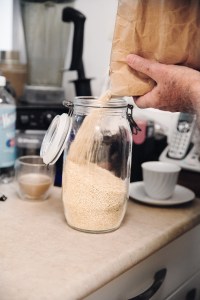Tech
The quinoa evangelist
Published
3 years agoon
By
Drew Simpson
In the early 1970s, Steve Gorad ’63 had a successful career as a clinical psychologist. He was in charge of the alcohol unit at Boston State Hospital and had a private practice, but he was restless. “It wasn’t enough,” he says. “I was a long-haired hippie writing [draft exemption] letters for people who didn’t want to go to Vietnam. I had doubts about what we really knew about psychology. I was a seeker.” So when Gorad’s boss at the hospital refused to give him time off to attend a 40-day spiritual workshop organized by a group called Arica, he quit. He immersed himself in Arica, turned his home in Boston’s South End into a commune, and traveled throughout Latin America. “My response to most everything during those years was to say yes,” he recalls.
While living in Chile, Gorad visited Bolivia. There he encountered quinoa, a grain considered peasant food in Latin America and relatively unknown elsewhere at the time. He was struck by its taste, and intrigued when told of its nutritional value. He began to study quinoa on frequent trips to the high-altitude region of Bolivia, called the Altiplano, where it’s widely grown, and by reading scientific papers. He learned that quinoa plants are often resilient even in the face of drought, flooding, and frost. He learned, too, that quinoa’s protein content is unusually high, ranging from 16 to 21% (compared with less than 14% for wheat and roughly 7.5% for rice). He also found that it contains all the “essential” amino acids—those that must come from food because the body can’t make them on its own—in proportions close to the nutritionally ideal ratio. “This makes the quality of quinoa protein roughly equivalent to that of milk (casein) or egg (albumin), without any of the disadvantages of coming from an animal source,” he has written. (Gorad credits MIT for giving him the tools to evaluate the science behind these nutritional claims. “MIT taught me the scientific method,” he says. “I can’t just accept claims because I’m told about them. I need to see proof, and that has served me throughout life—and certainly when it came to quinoa.”)
“I just had a sense that if I left the orderly path, my life wasn’t going to collapse. It would open into something else more exciting. And that is what happened.”
In the late 1970s, Gorad and two partners explored the possibility of importing quinoa into the United States. James Silver, who was the head of purchasing at Erewhon West, a natural foods company in Los Angeles, recalls hearing their pitch and realizing that quinoa’s nutritional properties made it an alluring product. “Quinoa wasn’t available in the US when they began this, at least not in any commercial sense. Certainly in the natural foods industry it did not exist,” Silver says. When Gorad and his partners founded Quinoa Corporation, in 1983, “they were the first, and for a very long time the only, importers of quinoa in the US.”
Gorad and his partners brought passion to their venture. “We were on a mission for quinoa,” he says, adding that in the early days they met with shoppers at natural food markets, handed out fliers, and “served little paper cups of cooked quinoa.” They sold small amounts of the grain with this approach but faced challenges in scaling up and securing a supply to import. Much of the grain available required extensive cleaning because it was “full of stones, dirt, dust, plant particles, pieces of metal, glass, unidentifiable objects, and even rodent feces,” Gorad recalls. (Eventually, Quinoa Corporation developed a relationship with the tea company Celestial Seasonings and used its industrial-scale machinery, including gravity tables, to clean the product.)
One year into the business, tragedy struck. One of Gorad’s partners, David Kusack, took an afternoon off from meeting with potential suppliers to visit an archaeological site in Bolivia; while sitting on a hilltop, he was shot in the back. His death was ruled a probable botched robbery, but theories abounded: it was a case of mistaken identity, business interests were threatened by quinoa farmers banding together, the CIA was behind it, quinoa was cursed. Whatever the cause, Gorad was devastated. “That almost stopped the project,” he says.
Quinoa Corporation persisted but continued to face turmoil. For a time, the company worked with the large natural foods distributors Eden Foods and Arrowhead Mills. But then these companies began to repackage the grain under their own names, ultimately finding their own Latin American suppliers and severing ties with Gorad and his partners. Their business struggled financially, even as the grain became more widely known. “Quinoa Corporation never had the money to do everything we needed to do,” Gorad recalls. “Not once did we place an ad or commercial for quinoa. What we did was make banners and little red buttons that simply said, ‘Quinoa is here.’ That was it.”
CELESTE SLOMAN
In 1986, Australia’s Great Eastern International bought Quinoa Corporation, offering an infusion of capital that allowed the business to expand and distribute the grain in the US. Gorad and his partners purchased equipment to process quinoa, hired more workers, and spent their reserves on a large shipment of the grain. They had overestimated demand, however, and the company once again hit hard times. In early 1988, Gorad resigned “in order to lessen the financial burden on the company,” he says. Even so, he continued to evangelize for quinoa. “I never felt I was taking myself out of the mission, out of the flow of things that needed to happen,” he says.
Over time, he watched quinoa’s popularity increase. Between 2007 and 2013, the amount imported into the US increased tenfold, from 7 million pounds to almost 70 million. Much of it came from Bolivia and Peru, both of which saw a sevenfold increase in quinoa exports between 2005 and 2013. The United Nations declared 2013 the “International Year of Quinoa” to recognize the work of indigenous farmers in the Andes who cultivated the grain. José Graziano de Silva, then director general of the UN’s Food and Agriculture Organization, proclaimed quinoa “an ally in the fight against hunger and food insecurity,” thanks to its nutritional benefits and ability to thrive under sometimes harsh agricultural conditions. It was also hailed as a promising crop in a world facing climate change.
The surge in demand led to drastic changes for indigenous farmers in the Andes. A pound of the grain, which sold for a mere 25 cents in 2000, began to command prices as high as $4. Anthropologist Emma McDonell has noted that this income allowed many farmers, who had lived at subsistence levels, to “send their children to university, invest in new motorcycles and cars, build new houses, and buy farming technology to increase their harvests.” As the boom continued, however, small farmers faced mounting competition from larger operations, including global agribusiness concerns. By 2014, the price of quinoa had dropped to 60 cents a pound.
Newspaper accounts from the time also claimed that many farmers no longer ate the grain their families had grown for generations, opting instead for less-nutritious noodles and rice so they could export their quinoa. But Gorad disputes this. “Not all of the quinoa they produced was exportable,” he says; the farmers he knew had enough for their own families while still bringing in additional income. “These people were dirt poor,” he says. “When the price of quinoa was going up, a lot of wealth came to Bolivia, which desperately needed it.”
Still, he acknowledges that the quinoa boom had its casualties. In some cases, farmers’ family members who had been working in the city came back to the farm to help out, he says. When the price dropped, those who had abandoned other work found themselves in trouble. “In individual cases, there are people who got messed up,” he says. “But the original farmers were still better off in the end than they would have been without the increased sales.”
Gorad himself did not reap outsize profits from quinoa either. After leaving Quinoa Corporation, he consulted on various international projects, including an effort to bring quinoa to Tibet. As distribution widened and new varieties were cultivated, he distributed seeds and information to those interested in growing the grain in the US and abroad. “I think I did more work promoting quinoa after I left Quinoa Corporation,” he says. “I was no longer constrained by the need to work for the benefit of the company. I worked for quinoa!” This work was mostly a labor of love—for seven years, Gorad worked as a legal assistant for a friend in Manhattan in order to pay his bills.
Today, Gorad lives in a Midtown skyscraper in New York, in the shadow of the Chrysler Building. He is retired and spends his days meditating and doing tai chi on the roof—a practice established long before covid-19 hit. (In fact, he sees the pandemic as an opportunity for the personal growth that comes with accepting change. Although ordinary life has been disrupted, “the bottom line is that we are still here, no matter what has been lost or changed,” he says.) He is quick to say that 20% of the apartments in his building are rent stabilized, including his, which he shares with a friend. “Quinoa didn’t make me rich,” he says. “I wasn’t a businessman and I am still not.”

CELESTE SLOMAN
Gorad is well aware of how unusual his life’s course has been, considering where he started. “I’m a Jewish kid from the Bronx. I’m a nerd,” he says. “Everything in my early life was programmed and planned. I just had a sense that if I left the orderly path, my life wasn’t going to collapse. It would open into something else more exciting. And that is what happened.”
“I was using business to accomplish a mission,” he adds. “I learned that from Buckminster Fuller, who lectured at MIT: you should do what you do because it’s good for humanity.”
In Gorad’s apartment, the kitchen and front hall closet are crammed with quinoa from all over the world: jars of pearly grains from Bolivia, packets of small white, red, and black grains, samples of a dark and sticky Canadian strain, almost like sticky rice. “I’ve been making cakes and breads with that,” he says, offering up a slice of a dark brown loaf that is dense and sweet. “I still feel that there’s no other food that’s as good to my body as quinoa.”
Steve Gorad’s Quinoa Corn Chowder
¼ cup quinoa
½ cup potato, cubed
2 Tbs carrot, diced
¼ cup onion, chopped
1 ½ cups corn kernels
2 cups water
2 cups milk
¼ cup parsley, chopped
Salt and black pepper to taste
Butter
Simmer quinoa, potato, carrot, and onion in water until soft (about 20 minutes). Add corn and simmer another 5 minutes. Add milk and bring just back to a boil. Season to taste. Add parsley and a bit of butter just before serving.
Steve Gorad’s Quinoa Corn Bread
2 cups corn meal
1 cup quinoa meal
1 tsp salt
½ tsp baking soda
1 ½ tsp baking powder
1 Tbs honey or brown sugar
1 large egg, beaten
3 Tbs melted butter
2 ½ cups buttermilk
Grind raw quinoa in a blender to make quinoa meal.
Mix wet ingredients together. Mix dry ingredients together. Combine the two. Bake in greased 9” x 9” pan or muffin tin at 425° F for about 25 minutes, or until golden brown.
You may like
Tech
The hunter-gatherer groups at the heart of a microbiome gold rush
Published
5 months agoon
12/19/2023By
Drew Simpson
The first step to finding out is to catalogue what microbes we might have lost. To get as close to ancient microbiomes as possible, microbiologists have begun studying multiple Indigenous groups. Two have received the most attention: the Yanomami of the Amazon rainforest and the Hadza, in northern Tanzania.
Researchers have made some startling discoveries already. A study by Sonnenburg and his colleagues, published in July, found that the gut microbiomes of the Hadza appear to include bugs that aren’t seen elsewhere—around 20% of the microbe genomes identified had not been recorded in a global catalogue of over 200,000 such genomes. The researchers found 8.4 million protein families in the guts of the 167 Hadza people they studied. Over half of them had not previously been identified in the human gut.
Plenty of other studies published in the last decade or so have helped build a picture of how the diets and lifestyles of hunter-gatherer societies influence the microbiome, and scientists have speculated on what this means for those living in more industrialized societies. But these revelations have come at a price.
A changing way of life
The Hadza people hunt wild animals and forage for fruit and honey. “We still live the ancient way of life, with arrows and old knives,” says Mangola, who works with the Olanakwe Community Fund to support education and economic projects for the Hadza. Hunters seek out food in the bush, which might include baboons, vervet monkeys, guinea fowl, kudu, porcupines, or dik-dik. Gatherers collect fruits, vegetables, and honey.
Mangola, who has met with multiple scientists over the years and participated in many research projects, has witnessed firsthand the impact of such research on his community. Much of it has been positive. But not all researchers act thoughtfully and ethically, he says, and some have exploited or harmed the community.
One enduring problem, says Mangola, is that scientists have tended to come and study the Hadza without properly explaining their research or their results. They arrive from Europe or the US, accompanied by guides, and collect feces, blood, hair, and other biological samples. Often, the people giving up these samples don’t know what they will be used for, says Mangola. Scientists get their results and publish them without returning to share them. “You tell the world [what you’ve discovered]—why can’t you come back to Tanzania to tell the Hadza?” asks Mangola. “It would bring meaning and excitement to the community,” he says.
Some scientists have talked about the Hadza as if they were living fossils, says Alyssa Crittenden, a nutritional anthropologist and biologist at the University of Nevada in Las Vegas, who has been studying and working with the Hadza for the last two decades.
The Hadza have been described as being “locked in time,” she adds, but characterizations like that don’t reflect reality. She has made many trips to Tanzania and seen for herself how life has changed. Tourists flock to the region. Roads have been built. Charities have helped the Hadza secure land rights. Mangola went abroad for his education: he has a law degree and a master’s from the Indigenous Peoples Law and Policy program at the University of Arizona.
Tech
The Download: a microbiome gold rush, and Eric Schmidt’s election misinformation plan
Published
5 months agoon
12/18/2023By
Drew Simpson
Over the last couple of decades, scientists have come to realize just how important the microbes that crawl all over us are to our health. But some believe our microbiomes are in crisis—casualties of an increasingly sanitized way of life. Disturbances in the collections of microbes we host have been associated with a whole host of diseases, ranging from arthritis to Alzheimer’s.
Some might not be completely gone, though. Scientists believe many might still be hiding inside the intestines of people who don’t live in the polluted, processed environment that most of the rest of us share. They’ve been studying the feces of people like the Yanomami, an Indigenous group in the Amazon, who appear to still have some of the microbes that other people have lost.
But there is a major catch: we don’t know whether those in hunter-gatherer societies really do have “healthier” microbiomes—and if they do, whether the benefits could be shared with others. At the same time, members of the communities being studied are concerned about the risk of what’s called biopiracy—taking natural resources from poorer countries for the benefit of wealthier ones. Read the full story.
—Jessica Hamzelou
Eric Schmidt has a 6-point plan for fighting election misinformation
—by Eric Schmidt, formerly the CEO of Google, and current cofounder of philanthropic initiative Schmidt Futures
The coming year will be one of seismic political shifts. Over 4 billion people will head to the polls in countries including the United States, Taiwan, India, and Indonesia, making 2024 the biggest election year in history.
Tech
Navigating a shifting customer-engagement landscape with generative AI
Published
5 months agoon
12/18/2023By
Drew Simpson
A strategic imperative
Generative AI’s ability to harness customer data in a highly sophisticated manner means enterprises are accelerating plans to invest in and leverage the technology’s capabilities. In a study titled “The Future of Enterprise Data & AI,” Corinium Intelligence and WNS Triange surveyed 100 global C-suite leaders and decision-makers specializing in AI, analytics, and data. Seventy-six percent of the respondents said that their organizations are already using or planning to use generative AI.
According to McKinsey, while generative AI will affect most business functions, “four of them will likely account for 75% of the total annual value it can deliver.” Among these are marketing and sales and customer operations. Yet, despite the technology’s benefits, many leaders are unsure about the right approach to take and mindful of the risks associated with large investments.
Mapping out a generative AI pathway
One of the first challenges organizations need to overcome is senior leadership alignment. “You need the necessary strategy; you need the ability to have the necessary buy-in of people,” says Ayer. “You need to make sure that you’ve got the right use case and business case for each one of them.” In other words, a clearly defined roadmap and precise business objectives are as crucial as understanding whether a process is amenable to the use of generative AI.
The implementation of a generative AI strategy can take time. According to Ayer, business leaders should maintain a realistic perspective on the duration required for formulating a strategy, conduct necessary training across various teams and functions, and identify the areas of value addition. And for any generative AI deployment to work seamlessly, the right data ecosystems must be in place.
Ayer cites WNS Triange’s collaboration with an insurer to create a claims process by leveraging generative AI. Thanks to the new technology, the insurer can immediately assess the severity of a vehicle’s damage from an accident and make a claims recommendation based on the unstructured data provided by the client. “Because this can be immediately assessed by a surveyor and they can reach a recommendation quickly, this instantly improves the insurer’s ability to satisfy their policyholders and reduce the claims processing time,” Ayer explains.
All that, however, would not be possible without data on past claims history, repair costs, transaction data, and other necessary data sets to extract clear value from generative AI analysis. “Be very clear about data sufficiency. Don’t jump into a program where eventually you realize you don’t have the necessary data,” Ayer says.
The benefits of third-party experience
Enterprises are increasingly aware that they must embrace generative AI, but knowing where to begin is another thing. “You start off wanting to make sure you don’t repeat mistakes other people have made,” says Ayer. An external provider can help organizations avoid those mistakes and leverage best practices and frameworks for testing and defining explainability and benchmarks for return on investment (ROI).
Using pre-built solutions by external partners can expedite time to market and increase a generative AI program’s value. These solutions can harness pre-built industry-specific generative AI platforms to accelerate deployment. “Generative AI programs can be extremely complicated,” Ayer points out. “There are a lot of infrastructure requirements, touch points with customers, and internal regulations. Organizations will also have to consider using pre-built solutions to accelerate speed to value. Third-party service providers bring the expertise of having an integrated approach to all these elements.”
